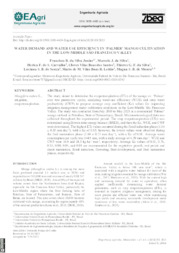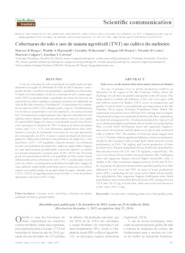Shade provided a microclimate that improved the performance of grapevines, apple trees and melon plants. White textile cover over melon croplands obtained a yield 35.15% higher than cultivation in full sun. Studies indicate that the blanket cover favors the photosynthesis process. To fight heat, water supplementation alone is not enough, as plant performance is also affected by factors such as solar radiation and air humidity. Since the beginning of measurements in the 1970s, the weather station in the Brazilian semi-arid region has recorded several episodes of anomaly in the average air temperature. The excess heat recorded in recent months has strong impacts on plants, and only increasing the water supply relieves but does not solve the problem. That is the explanation by three Embrapa scientists who are used to analyzing the behavior of plant species in one of the hottest areas of the country, the Semi-arid region, which is mostly located in the countryside of the Brazilian Northeast. Researchers Magna Moura, Saulo Aidar and Agnaldo Rodrigues, from Embrapa Semi-arid Region, clarify that the impacts depend on several factors, including the phenological stage in which each plant is. In fruit trees, for instance, it can cause the abortion of the flower buds – which would originate the fruits – or burn those that are already in the ripening stage – a process known as scald. It can also reduce gas exchanges and affect crop yield. Experiments have shown that shading screens protecting crops have helped mitigate the effects of heat. A study with the cultivation of apple trees proved that the use of this structure for shading in the orchard resulted in better photosynthetic performance compared to the environment in full sun. "This result shows that, at certain times of the year, solar radiation in the region is naturally excessive for the photosynthesis of some crops, and can impact physiological performance not only due to the amount of light energy, but also due to the excessive warming of the environment in the middle of the day," Moura says. A study with hybrid canary melons grown under irrigation and in full sun showed that gas exchanges in the leaves progressively decreased in the course of the morning. In that condition, photosynthesis reached the lowest levels after 1pm, when leaf temperature presented the highest values recorded (around 36.7 ºC). The experiment also included the cultivation of the same variety of melon, at the same age and in the same area, but using a white textile cover. It resulted in larger opening of the stomata throughout the day, which allowed for further transpiration and hence less leaf warming. Chaves says that the use of textile cover promoted a more favorable microclimate for plants' physiological performance, mitigating the potential thermal stress factor in the crop. "Even under lower photosynthetically active solar radiation, photosynthesis was favored and contributed to a yield 35.15% higher than in the condition of full sun cultivation," he observes. Effect of the environment on fruit trees Assessing the temperature of the leaves of grapevines, one of the main crops in the region, on a day of extreme heat, the researchers observed an increase of approximately 8º C in leaf temperature between measurements taken early in the morning and around 1 pm. The measurements were made through thermal images from the early hours of the morning, when temperatures are lower, to right after noon, when the highest figures occur. They also noticed differences in the temperatures found on different sides of the plant, showing that the direct incidence of solar radiation is also a relevant factor. In mango leaves, another one of the most important crops in the region, there was a difference of approximately 9 °C between the shaded and sun sides, in a measurement also made at around 1 pm. In the physiological assessments of the BRS Melodia table grape variety, the stomata closing rate observed was around 35.5%. This caused a 47% decrease in plants' ability to perform photosynthesis, a behavior identified in the measurements between 9:30 am and 12 pm. Despite the stomata closing, changes in air temperature and humidity caused a slight increase in leaf transpiration: around 8%. This, however, was not enough to keep the leaves cool, as their temperatures increased from 34.4 ºC to 40.7 ºC. Permanent attention Moura points out that, although the agrometeorological variations in the spring of 2023 reached above average air temperature records, it is important to consider that thermal and oxidative stress conditions can be present in several periods of the year, especially in hot regions like the lower middle São Francisco river valley. Studies held with different crops in the region show such reality. In Palmer variety mango trees' flowering stage in March 2021, there was a 13.7% decrease in photosynthesis, with an increase in leaf temperature from 31.3 ºC to 34.8 ºC between the hours of 9:50 am and 11:50 am. Findings like these also show that, on top of adjusting irrigation, other crop-specific measures can also be adopted to minimize the effects of high temperatures on plants. Saulo Aidar concludes: “All those factors tend to decrease physiological performance and thus plant productivity. Therefore, if it is possible to improve management in such conditions, there will certainly be productivity gains, input savings, lower production costs and better final yield in the commercial production success”. How extreme temperatures affect agriculture Climate conditions are one of the main reasons for the success of national agricultural production, which makes Brazil a top exporter of agricultural products, in addition to producing food for its own population. With the arrival of spring, the period air warming usually starts in most of the country, when temperatures tend to rise until the end of summer. This year, however, the last ten days of September and the first days of October, and again in the first half of November, Brazil experienced temperatures well above normal: between 2 ºC and 3 ºC increases above the average in most of the country, and above 7 ºC on some days and places. In part of the Brazilian Northeast temperatures are already high throughout the year, as this area is located in a region that is closer to the Equator, which receives high levels of solar radiation all year round. Therefore, the intense heat is already part of the daily life of plants grown in one of the most important fruit farming regions in the country, the Lower Middle São Francisco River Valley. Located in the semi-arid region, around the cities of Petrolina, in Pernambuco, and Juazeiro, in Bahia, the region has an average annual temperature of 27oC, and the average maximum temperature is around 34oC in the months of October and November. This year, however, thermometers recorded figures above 39 oC, that is, about 5 oC above the average. "Under such conditions, the main fruit crops produced in this region, where they are grown under irrigation, also suffer negative impacts," states Magna Moura, a researcher from Embrapa. She observes that these patterns have repeated themselves, which has been noted at least since the 1970s, when Embrapa Semi-arid Region started taking temperature measurements at the Bebedouro Agrometeorological Station in Petrolina, Pernambuco. During this period, several episodes of anomaly in the average air temperature were observed, with peaks that reached up to about 5oC above the historical average. The same has also happened for below-average temperatures, when the lowest figures are associated with rainfall events. The researcher explains that, on a sunny and cloudless day, the increase in solar radiation is accompanied by an increase in soil and air temperature and, consequently, a decrease in relative air humidity. That increases the speed at which water is lost by the leaves, which may not always be at the same speed of replenishment, leading to dehydration. Just water is not enough If one of the main recommendations for people to face the heat safely is to hydrate, would increasing water supply also be a solution to the problem in plants? The answer is yes and no.. The researcher Saulo Aidar points out that, "under optimal soil moisture conditions, the negative physiological effects caused by heat can be reduced, so it is important to adjust irrigation, also considering that in those periods the soil water evaporation rate is also higher". However, water alone cannot eliminate the impacts of high temperatures, as plant performance is also affected by the interaction with other factors, such as solar radiation and air humidity. According to Aidar, in very hot periods, even if there is water in the soil, a plant can keep showing an aspect of lack of water – a situation known as physiological drought. The most common symptoms are curling and changes in leaf inclination, depending on the time of day, for some crops that have this characteristic, aiming to reduce the absorption of sunlight. The researcher recalls that physiological drought can also occur due to other causes, such as excess fertilizer in the soil, excessive salinization of the environment, or even excess water, causing soil waterlogging. Pests and root diseases can also limit plant development, which can appear to be a plant difficulty in absorbing water. "That is why it is important to correctly identify the causes in order to seek suitable management," he concludes. Natural plant protection The plants themselves already have natural solutions to deal with those problems, maintaining – at least for some time – the best possible performance in the environmental condition in which they find themselves. For instance: when the air is very hot, especially around noon, plants tend to close the pores of the leaves, which are the stomata, to save water or prevent dehydration, even if there is water available in the soil. This is because the speed the leaves lose water can be greater than the speed of water absorption from the soil. The closing of the stomata, however, also entails a decrease in gas exchange, preventing carbon dioxide (CO2) from entering the leaf. This gas is essential for photosynthesis, which is the process by which plants produce energy in their cells. Thus, the lack of CO2 for photosynthesis decreases the energy gain responsible for plant growth and productivity. In addition, the closing also limits transpiration, which is the loss of water vapor through the stomata, causing the leaves to warm up, which also reduces the efficiency of photosynthesis. "When transpiration and photosynthesis are decreased, the same amount of light energy from solar radiation becomes excessive for the leaves, causing photo-inhibition – the inhibition of photosynthesis – and photo-oxidation – the degradation of compounds and cell structures –, processes that are both caused by excess light," Aidar says. He states that, in this situation, there is a physiological activation of protective mechanisms to “neutralize” the harmful effects of excess light, with thermal energy dissipation and the induction of antioxidant systems in the plant. This occurs, for instance, through the action of enzymes and other substances that protect leaves and other organs against oxidation reactions. Thus, the activation of these mechanisms aims to avoid the degradation of compounds and cell structures that can be visually identified as a bronzing in the color of leaves and fruits, but which can evolve into necroses that look like "burns". Photos on this page by: Magna de Moura
Photo: Magna Soelma Beserra de Moura
![Magna Soelma Beserra de Moura - Em fruteiras, por exemplo, o excesso de calor pode causar o abortamento dos botões florais – que dariam origem aos frutos Magna Soelma Beserra de Moura - Em fruteiras, por exemplo, o excesso de calor pode causar o abortamento dos botões florais – que dariam origem aos frutos]()
Em fruteiras, por exemplo, o excesso de calor pode causar o abortamento dos botões florais – que dariam origem aos frutos
The excess heat recorded in recent months has strong impacts on plants, and only increasing the water supply relieves but does not solve the problem. That is the explanation by three Embrapa scientists who are used to analyzing the behavior of plant species in one of the hottest areas of the country, the Semi-arid region, which is mostly located in the countryside of the Brazilian Northeast.
Researchers Magna Moura, Saulo Aidar and Agnaldo Rodrigues, from Embrapa Semi-arid Region, clarify that the impacts depend on several factors, including the phenological stage in which each plant is. In fruit trees, for instance, it can cause the abortion of the flower buds – which would originate the fruits – or burn those that are already in the ripening stage – a process known as scald. It can also reduce gas exchanges and affect crop yield.
Experiments
have shown that shading screens protecting crops have helped mitigate the effects of heat. A study with the cultivation of apple trees proved that the use of this structure for shading in the orchard resulted in better photosynthetic performance compared to the environment in full sun.
"This result shows that, at certain times of the year, solar radiation in the region is naturally excessive for the photosynthesis of some crops, and can impact physiological performance not only due to the amount of light energy, but also due to the excessive warming of the environment in the middle of the day," Moura says.
A study with hybrid canary melons grown under irrigation and in full sun showed that gas exchanges in the leaves progressively decreased in the course of the morning. In that condition, photosynthesis reached the lowest levels after 1pm, when leaf temperature presented the highest values recorded (around 36.7 ºC).
The experiment also included the cultivation of the same variety of melon, at the same age and in the same area, but using a white textile cover. It resulted in larger opening of the stomata throughout the day, which allowed for further transpiration and hence less leaf warming.
Chaves says that the use of textile cover promoted a more favorable microclimate for plants' physiological performance, mitigating the potential thermal stress factor in the crop. "Even under lower photosynthetically active solar radiation, photosynthesis was favored and contributed to a yield 35.15% higher than in the condition of full sun cultivation," he observes.
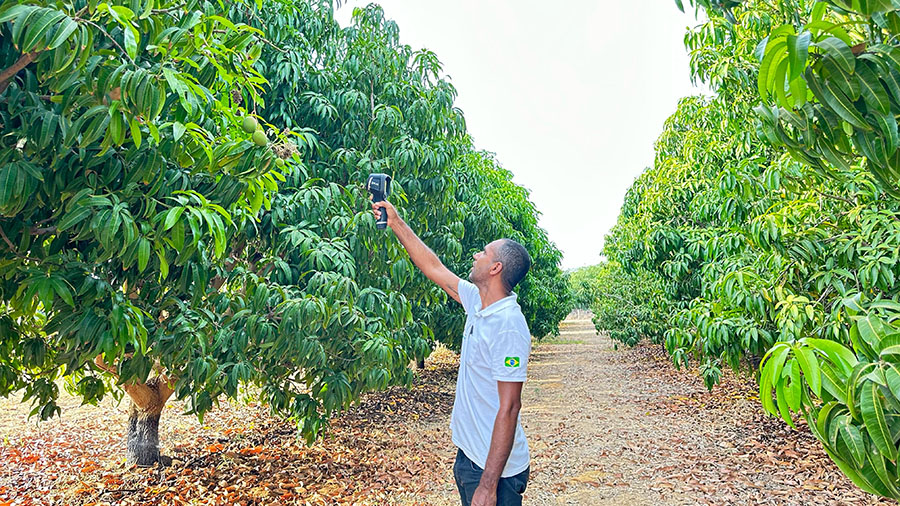
Effect of the environment on fruit trees
Assessing the temperature of the leaves of grapevines, one of the main crops in the region, on a day of extreme heat, the researchers observed an increase of approximately 8º C in leaf temperature between measurements taken early in the morning and around 1 pm. The measurements were made through thermal images from the early hours of the morning, when temperatures are lower, to right after noon, when the highest figures occur.
They also noticed differences in the temperatures found on different sides of the plant, showing that the direct incidence of solar radiation is also a relevant factor. In mango leaves, another one of the most important crops in the region, there was a difference of approximately 9 °C between the shaded and sun sides, in a measurement also made at around 1 pm.
In the physiological assessments of the BRS Melodia table grape variety, the stomata closing rate observed was around 35.5%. This caused a 47% decrease in plants' ability to perform photosynthesis, a behavior identified in the measurements between 9:30 am and 12 pm.
Despite the stomata closing, changes in air temperature and humidity caused a slight increase in leaf transpiration: around 8%. This, however, was not enough to keep the leaves cool, as their temperatures increased from 34.4 ºC to 40.7 ºC.

Permanent attention
Moura points out that, although the agrometeorological variations in the spring of 2023 reached above average air temperature records, it is important to consider that thermal and oxidative stress conditions can be present in several periods of the year, especially in hot regions like the lower middle São Francisco river valley.
Studies held with different crops in the region show such reality. In Palmer variety mango trees' flowering stage in March 2021, there was a 13.7% decrease in photosynthesis, with an increase in leaf temperature from 31.3 ºC to 34.8 ºC between the hours of 9:50 am and 11:50 am.
Findings like these also show that, on top of adjusting irrigation, other crop-specific measures can also be adopted to minimize the effects of high temperatures on plants.
Saulo Aidar concludes: “All those factors tend to decrease physiological performance and thus plant productivity. Therefore, if it is possible to improve management in such conditions, there will certainly be productivity gains, input savings, lower production costs and better final yield in the commercial production success”.
 How extreme temperatures affect agriculture How extreme temperatures affect agriculture
Climate conditions are one of the main reasons for the success of national agricultural production, which makes Brazil a top exporter of agricultural products, in addition to producing food for its own population. With the arrival of spring, the period air warming usually starts in most of the country, when temperatures tend to rise until the end of summer. This year, however, the last ten days of September and the first days of October, and again in the first half of November, Brazil experienced temperatures well above normal: between 2 ºC and 3 ºC increases above the average in most of the country, and above 7 ºC on some days and places. 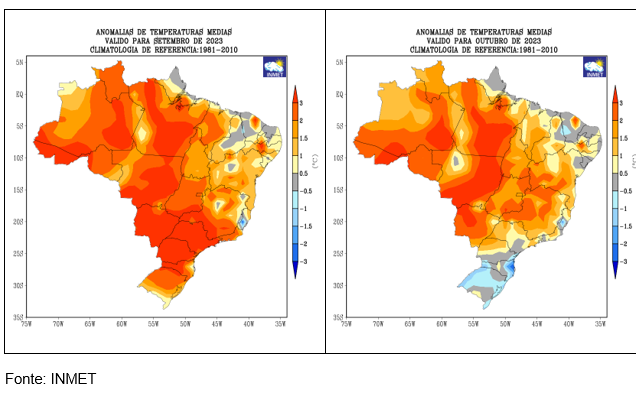
In part of the Brazilian Northeast temperatures are already high throughout the year, as this area is located in a region that is closer to the Equator, which receives high levels of solar radiation all year round. Therefore, the intense heat is already part of the daily life of plants grown in one of the most important fruit farming regions in the country, the Lower Middle São Francisco River Valley. Located in the semi-arid region, around the cities of Petrolina, in Pernambuco, and Juazeiro, in Bahia, the region has an average annual temperature of 27oC, and the average maximum temperature is around 34oC in the months of October and November. This year, however, thermometers recorded figures above 39 oC, that is, about 5 oC above the average. "Under such conditions, the main fruit crops produced in this region, where they are grown under irrigation, also suffer negative impacts," states Magna Moura, a researcher from Embrapa. She observes that these patterns have repeated themselves, which has been noted at least since the 1970s, when Embrapa Semi-arid Region started taking temperature measurements at the Bebedouro Agrometeorological Station in Petrolina, Pernambuco. During this period, several episodes of anomaly in the average air temperature were observed, with peaks that reached up to about 5oC above the historical average. The same has also happened for below-average temperatures, when the lowest figures are associated with rainfall events. 
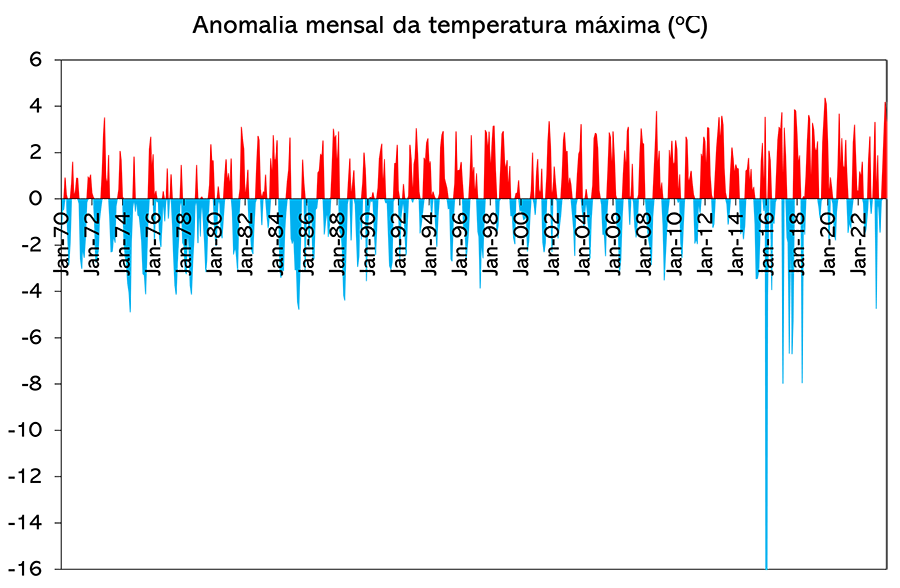
The researcher explains that, on a sunny and cloudless day, the increase in solar radiation is accompanied by an increase in soil and air temperature and, consequently, a decrease in relative air humidity. That increases the speed at which water is lost by the leaves, which may not always be at the same speed of replenishment, leading to dehydration. |
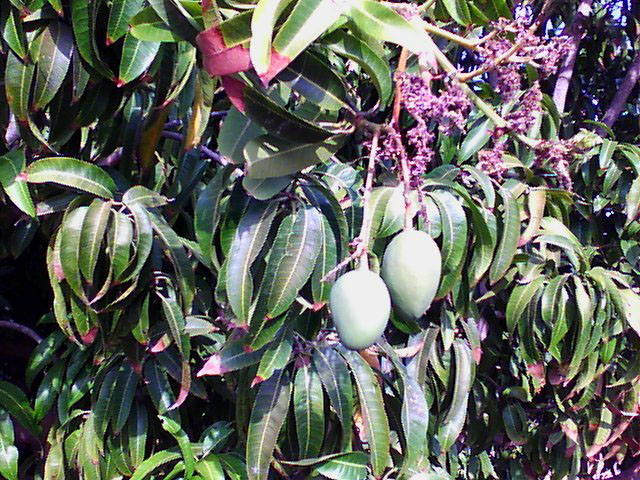 Just water is not enough
Just water is not enough
If one of the main recommendations for people to face the heat safely is to hydrate, would increasing water supply also be a solution to the problem in plants? The answer is yes and no..
The researcher Saulo Aidar points out that, "under optimal soil moisture conditions, the negative physiological effects caused by heat can be reduced, so it is important to adjust irrigation, also considering that in those periods the soil water evaporation rate is also higher". However, water alone cannot eliminate the impacts of high temperatures, as plant performance is also affected by the interaction with other factors, such as solar radiation and air humidity.
According to Aidar, in very hot periods, even if there is water in the soil, a plant can keep showing an aspect of lack of water – a situation known as physiological drought. The most common symptoms are curling and changes in leaf inclination, depending on the time of day, for some crops that have this characteristic, aiming to reduce the absorption of sunlight.
The researcher recalls that physiological drought can also occur due to other causes, such as excess fertilizer in the soil, excessive salinization of the environment, or even excess water, causing soil waterlogging. Pests and root diseases can also limit plant development, which can appear to be a plant difficulty in absorbing water. "That is why it is important to correctly identify the causes in order to seek suitable management," he concludes.
 Natural plant protection Natural plant protection
The plants themselves already have natural solutions to deal with those problems, maintaining – at least for some time – the best possible performance in the environmental condition in which they find themselves. For instance: when the air is very hot, especially around noon, plants tend to close the pores of the leaves, which are the stomata, to save water or prevent dehydration, even if there is water available in the soil. This is because the speed the leaves lose water can be greater than the speed of water absorption from the soil. The closing of the stomata, however, also entails a decrease in gas exchange, preventing carbon dioxide (CO2) from entering the leaf. This gas is essential for photosynthesis, which is the process by which plants produce energy in their cells. Thus, the lack of CO2 for photosynthesis decreases the energy gain responsible for plant growth and productivity. In addition, the closing also limits transpiration, which is the loss of water vapor through the stomata, causing the leaves to warm up, which also reduces the efficiency of photosynthesis. "When transpiration and photosynthesis are decreased, the same amount of light energy from solar radiation becomes excessive for the leaves, causing photo-inhibition – the inhibition of photosynthesis – and photo-oxidation – the degradation of compounds and cell structures –, processes that are both caused by excess light," Aidar says. He states that, in this situation, there is a physiological activation of protective mechanisms to “neutralize” the harmful effects of excess light, with thermal energy dissipation and the induction of antioxidant systems in the plant. This occurs, for instance, through the action of enzymes and other substances that protect leaves and other organs against oxidation reactions. Thus, the activation of these mechanisms aims to avoid the degradation of compounds and cell structures that can be visually identified as a bronzing in the color of leaves and fruits, but which can evolve into necroses that look like "burns". Photos on this page by: Magna de Moura |
Fernanda Birolo (MTb 81/AC)
Embrapa Semi-arid Region
Press inquiries
semiarido.imprensa@embrapa.br
Phone number: +55 87 3666-3734
Translation: Mariana Medeiros (13044/DF)
Superintendency of Communication
Further information on the topic
Citizen Attention Service (SAC)
www.embrapa.br/contact-us/sac/

 Just water is not enough
Just water is not enough






 Natural plant protection
Natural plant protection